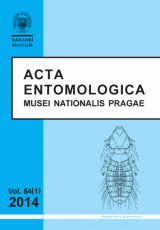Biology and morphology of immature stages of Coniocleonus nigrosuturatus (Coleoptera: Curculionidae: Lixinae)
Stejskal Robert, Trnka Filip, Skuhrovec Jiří
Acta Entomologica Musei Nationalis Pragae 54(1): 337-354, 2014
Views: 1304
Abstract: Mature larvae and pupae of Coniocleonus (Plagiographus) nigrosuturatus (Goeze,
1777) (Curculionidae: Lixinae: Cleonini) are described and compared with three
other cleonine taxa with known larvae. The biology of the species was studied in
Romania, Hungary and Slovakia. Common Stork's-bill (Erodium cicutarium)
(Geraniaceae) is identified as a host plant of both larvae and adults of this
weevil. The weevil is very likely monophagous, and previous records of thyme
(Thymus sp., Lamiaceae) as the host plant hence appear incorrect. Coniocleonus
nigrosuturatus prefers dry, sunny places in grassland habitats, with sparse
vegetation, bare ground and patchily growing host plants. Overwintering beetles
emerge in early spring (March), feed and mate on the host plants. The highest
activity of adults was observed from mid-April to mid-May. Larvae live in the
soil in a vertical tunnel near the host plant and feed externally on the base of
the stem. Usually, a single larva was observed at an attacked plant, however,
sometimes up to 3 larvae were found. At the beginning of July, the larvae
pupate in a closed earthen cell. A reared adult emerged in the laboratory at
the end of July. We suppose that part of the population overwinters in pupation
cells, although some adults leave the cells at the end of summer. They then most
likely spend some time feeding on the host plants and look for suitable shelters
in which to overwinter later.
Key words: Coleoptera; Curculionidae; Lixinae; Coniocleonus nigrosuturatus; mature larva; pupa; morphology; host plant; Erodium cicutarium; Geraniaceae; larval development; life history; central Europe; Palaearctic Region
Papers
Chewing lice (Phthiraptera: Amblycera et Ischnocera) from wrens (Passeriformes: Troglodytidae), with description of a new species of MyrsideaA new species of Eremiothrips from Iran (Thysanoptera: Thripidae)Preimaginal stages and biology of Bactericera lyrata (Hemiptera: Psylloidea: Triozidae)Notes on the tribe Tongini, with description of a new species of the genus Orthophana from northern Vietnam (Hemiptera: Fulgoroidea: Nogodinidae)A new species of Cofana associated with grasses from India (Hemiptera: Cicadellidae: Cicadellinae)Taxonomic revision of the Neotropical genus Oiovelia (Hemiptera: Heteroptera: Veliidae)Revision of the genus Tachytatus (Heteroptera: Lygaeoidea: Rhyparochromidae)Afromenotes hirsuta, a new genus and species of Eumenotini from the Democratic Republic of the Congo (Hemiptera: Heteroptera: Dinidoridae)A revision of the genus Amblycara (Hemiptera: Heteroptera: Pentatomidae)Taxonomy and biology of the bromeliad-inhabiting genus Lachnodacnum (Coleoptera: Hydrophilidae: Sphaeridiinae)New species and subspecies of Octavius from South Africa, with a key and additional distribution records (Coleoptera: Staphylinidae: Euaesthetinae)Batrisceniola fengtingae sp. nov., the first record of the genus in China (Coleoptera: Staphylinidae: Pselaphinae)A new Callosides species from Ecuador with uniquely built membranous mandibles (Coleoptera: Hybosoridae: Anaidinae)New data about 'nalassoid' genera from south-eastern Anatolia with description of a new species of Zophohelops (Coleoptera: Tenebrionidae)A new species of the genus Callomecyna from Taiwan (Coleoptera: Cerambycidae)Review of Imatidiini genera (Coleoptera: Chrysomelidae: Cassidinae)Taxonomy of the Cape Verde endemic weevil genus Dinas (Coleoptera: Curculionidae: Entiminae). Part I: Description of a new subgenus, and two new species from S?o Nicolau IslandBiology and morphology of immature stages of Coniocleonus nigrosuturatus (Coleoptera: Curculionidae: Lixinae)Two new species of Austrolimnophila from the Mediterranean (Diptera: Limoniidae)Cladistic analysis of Rheochlus and related genera, with description of a new species (Diptera: Chironomidae: Podonominae)A new species of Feuerborniella (Diptera: Psychodidae) from the paramo of ColombiaThe identity and family affiliation of Scelomyza hirticornis (Diptera: Opomyzidae, Anthomyzidae), with a new checklist of Afrotropical AnthomyzidaeCatalogue of the type specimens deposited in the Department of Entomology, National Museum, Prague, Czech Republic. Polyneoptera 